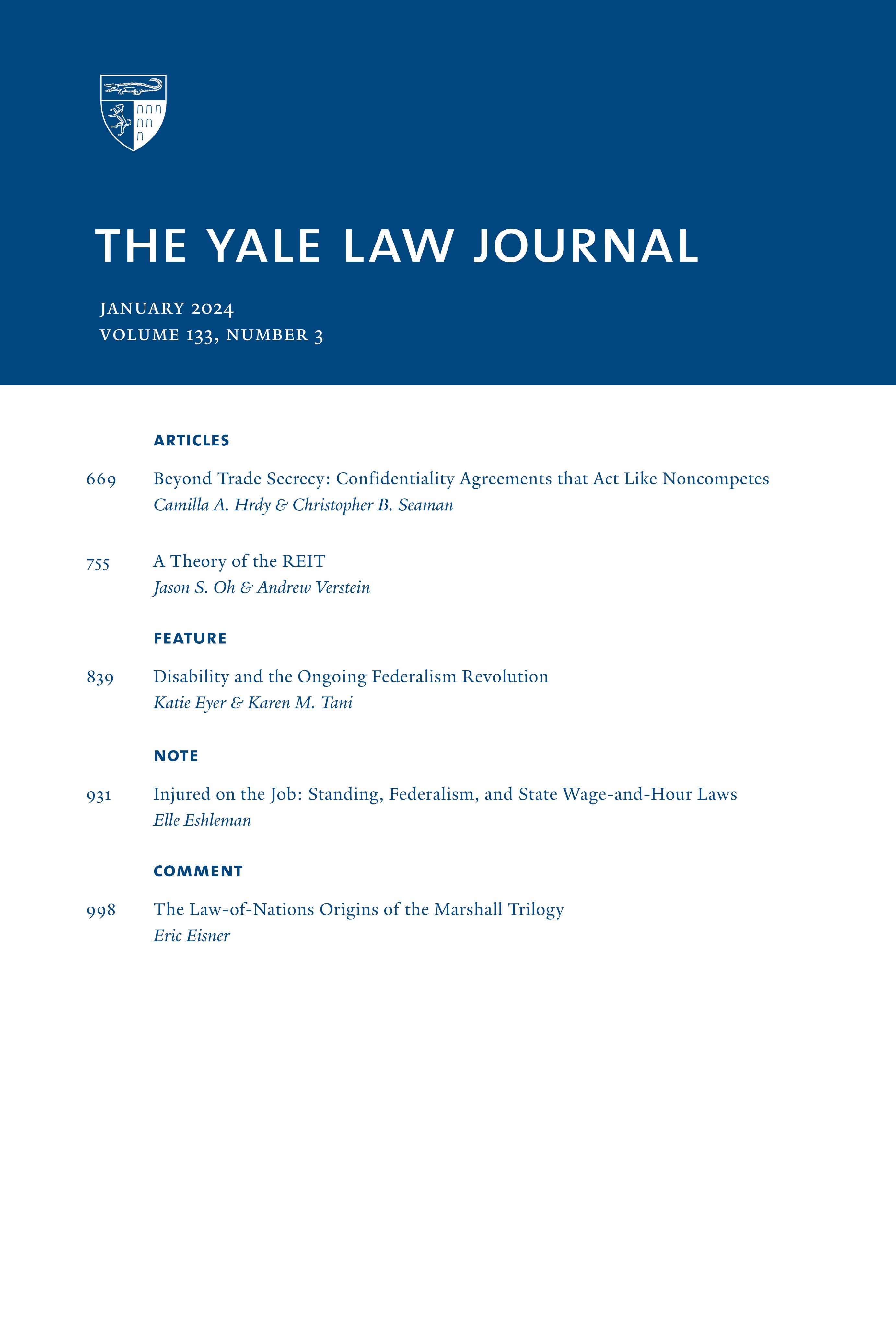第七章的法定历史和LGBT工作场所保护的性别歧视论点
IF 5.2
1区 社会学
Q1 LAW
引用次数: 16
摘要
平等就业机会委员会(EEOC)和第七巡回法院的立场是,第七章禁止“基于性别”的就业歧视适用于对女同性恋、男同性恋、双性恋和变性人(LGBT)的歧视。这种解释是根据《规约》的一般含义,从整体上并根据其目的来解读的。如果雇主解雇一名女性是因为她嫁给了另一个女人,而不是嫁给了一个男人,那么从字面上讲,雇主的行为“是因为”她的性别(如果她是一个男人,和一个女人结婚是可以的),也因为她伴侣的性别。很难否认,在雇佣决定中,“性别”至少不是一个“激励因素”,而这正是当前版本的第七章对责任的全部要求。此外,对第七章的这种解读符合其目的,即确立一个以能力为基础的工作场所,在这种工作场所,特定的特征或地位标准(种族、肤色、国籍、宗教和性别)应该与一个人的工作机会无关。将反同性恋歧视视为一种性别歧视并不是一个新想法,但几十年来,大多数联邦法官都拒绝了这一观点,大多数国会议员都对此视而不见。然而,这是一个随着时间的推移而成熟的想法。新的情况使这一论点不仅似是而非,而且令人信服。最大的新发展是关于性少数群体的社会事实和假设:1964年,被认为是“同性恋”的员工不在以业绩为基础的工作场所的范围内,因为美国人认为他们有精神疾病、精神变态和掠夺性。今天,这些观点已经不可信,这与第二个新情况有关,一个完全不同的宪法基线。直到2003年,“同性恋者”还可以被宪法认定为推定罪犯,但最高法院20年来一直在制定一项宪法规范,即不能因为同性恋者的身份而将其排除在法律之外。事实上,最高法院已经裁定,宪法规定的结婚权利适用于同性(即“同性恋”)伴侣。在大多数州,一对女同性恋伴侣可以在周六结婚,周一就被解雇,而没有法律补偿,这在宪法上是不和谐的。第三个新的发展是第七章本身的正式演变。法官和评论家在很大程度上忽略了第七章的“法定历史”——它经过国会的修订和最高法院的权威解释的正式演变。特朗普政府和其他对广泛解读性别歧视持怀疑态度的人认为,第七章将世界划分为男性和女性,除了要求雇主对男女适用同样的规则外,没有别的规定;反同性恋工作场所的排斥或骚扰对两性都是平等的(即女同性恋和男同性恋都受到伤害)。但最高法院对第七章的权威解释是禁止性别刻板印象,这种刻板印象也同样适用于保护男性和女性员工。国会在1991年对第七章的修正案中批准并扩大了这一解释,该修正案还重申了其法定使命,即确保以成绩为基础的工作场所不受基于性别的决策的影响,即使性别只是歧视的一个“激励因素”。由于LGBT群体属于性别少数群体,而且针对LGBT的歧视根植于僵化的性别角色,《第七章》今天禁止因雇员伴侣/配偶的性别而歧视,就像禁止因其伴侣/配偶的种族或宗教而歧视一样。本文章由计算机程序翻译,如有差异,请以英文原文为准。
Title VII's Statutory History and the Sex Discrimination Argument for LGBT Workplace Protections
The Equal Employment Opportunity Commission (EEOC) and the Seventh Circuit have taken the position that Title VII’s bar to employment discrimination “because of * * * sex” applies to discrimination against lesbian, gay, bisexual, and transgender (LGBT) persons. This interpretation follows from the ordinary meaning of the statute, read as a whole and in light of its purpose. If an employer fires a woman because she is married to another woman, rather than a man, the employer has, literally, acted “because of” her sex (if she had been a man, marriage to a woman would have been fine) and because of the sex of her partner. It is hard to deny that “sex” is not at least one “motivating factor” in the employment decision, which is all that the current version of Title VII requires for liability. Moreover, this reading of Title VII accords with its purpose, which is to entrench a merit-based workplace where specified traits or status-based criteria (race, color, national origin, religion, and sex) are supposed to be irrelevant to a person’s job opportunities.
Treatment of anti-gay discrimination as a form of sex discrimination is not a new idea, but for several decades most federal judges have rejected it, and most Members of Congress have ignored it. This is an idea that has ripened over time, however. New circumstances have rendered the argument not only plausible but compelling. The biggest new development has been social facts and assumptions about sex minorities: In 1964, employees thought to be “homosexuals” were outside the scope of the merit-based workplace, because Americans believed them to be mentally ill, psychopathic, and predatory. Today, those views have been discredited, and this connects with a second new circumstance, a radically different constitutional baseline. As late as 2003, “homosexuals” could constitutionally be considered presumptive criminals, but the Supreme Court has for twenty years been developing a constitutional norm that gay people cannot be excluded from the law because of who they are. Indeed, the Court has ruled that the constitutional right to marry applies to same-sex (i.e., “homosexual”) couples. It is constitutionally jarring to know that, in most states, a lesbian couple can get married on Saturday and be fired from their jobs on Monday, without legal redress.
A third new development has been the formal evolution of Title VII itself. Judges as well as commentators have largely ignored the “statutory history” of Title VII — its formal evolution through a process of amendment by Congress and authoritative interpretation by the Supreme Court. The Trump Administration and other skeptics of a broad reading of sex discrimination maintain that Title VII divides the world into males and females and does nothing more than require employers to apply the same rules to both sexes; anti-homosexual workplace exclusions or harassment operates equally on both sexes (i.e., both lesbians and gay men are harmed). But the Supreme Court has authoritatively interpreted Title VII to bar gender stereotyping, which also operates to protect both male and female employees alike. Congress ratified and expanded upon that interpretation in its 1991 Amendments to Title VII, which also reaffirmed its statutory mission to ensure a merit-based workplace free from sex-based decision making, even when sex is but one “motivating factor” in the discrimination. Because LGBT persons are gender minorities and because anti-LGBT discrimination is rooted in rigid gender roles, Title VII today bars discrimination because of the sex of the employee’s partner/spouse, just as it bars discrimination because of the race or religion of his or her partner/spouse.
求助全文
通过发布文献求助,成功后即可免费获取论文全文。
去求助
来源期刊

Yale Law Journal
LAW-
CiteScore
4.50
自引率
6.20%
发文量
0
期刊介绍:
The Yale Law Journal Online is the online companion to The Yale Law Journal. It replaces The Pocket Part, which was the first such companion to be published by a leading law review. YLJ Online will continue The Pocket Part"s mission of augmenting the scholarship printed in The Yale Law Journal by providing original Essays, legal commentaries, responses to articles printed in the Journal, podcast and iTunes University recordings of various pieces, and other works by both established and emerging academics and practitioners.
 求助内容:
求助内容: 应助结果提醒方式:
应助结果提醒方式:


